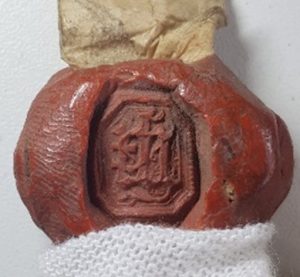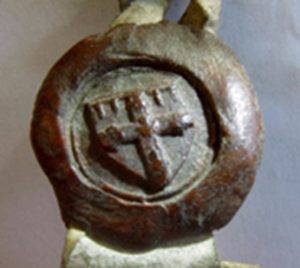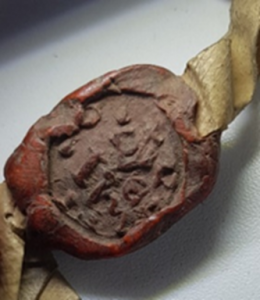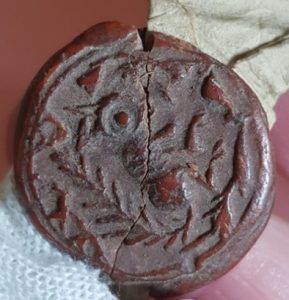Worcestershire’s Medieval Seals
- 7th July 2022
Vicky, one of our our archivists, has been working on a project looking at medieval seals and shares what she has found.
In the medieval era, most people would have had access to a seal matrix with which to impress their own individual seal, which acted like a signature as a mark of authenticity on a variety of legal documents. Worcestershire Archives and Archaeology Service hold many of these fascinating documents, which can tell us much about the past inhabitants of the county, their everyday lives and social networks. Most of these documents will include at least one of these personal seals (sometimes many more!) and these can tell us even more about their medieval owners as they are often highly individual and a way in which medieval people could express an idea of themselves.
Often, the seals on a document do not have full catalogue descriptions, and work is taking place nationally to address this. A set of guidelines is being developed to enable heritage professionals to describe the seals in their collections in a quick, easy and standardised way. When complete these guidelines will mean increased visibility of seals in collections, which is great news for researchers as they can tell us much about not just the people who used them but also wider cultural changes and trends across societies – for example in the arts and religion.
As a self-confessed seals fan the past few months have been very exciting for me as I have been working on testing the pilot version of these guidelines. This work has involved close examination of the medieval seals in our collections and noting various information, such as the type of design and any text as well as information on the condition of the seal and even if any additional material is embedded into it such as hair or fingerprints – which are always a nice thing to find as they are such an immediate link with the past. The seals are fascinating to work with, as the subject matter for motifs is endless. Here are a few examples I found when working on this project.
You can see fingerprints clearly on the left hand side of this impression, which can be found on a deed dating from 1426 relating to property in Worcester.
Personal seals are also fantastic resources for the study of heraldry. There are many seals in our collections that show coats of arms, and these are not just seals of royalty and the nobility, but seals of everyday people too, such as this example which can be found on a document dating from 1389, involving leasing of property in Worcester High Street.
This seal has a design which is form of ‘sacred’ or ‘holy monogram’ or ‘Christogram’. It derives from the Greek name for Jesus, abbreviated to ‘IHS’ or ‘IHC’. It has been found in religious art and decoration for many centuries and continues to be used as a Christian motif. It is attached to a document dating from 1385 and relates to property in Baxter Street in Worcester – known since the 17th Century as The Shambles.
Animals were a popular choice of motif, and could vary considerably in style. This little squirrel is my favourite of all the seals I’ve looked at for this project. It can be found attached to a document dating from 1411, and is likely to have belonged to Agnes Caynard, who was releasing a garden and dovecot outside of The Foregate in Worcester to John Deperton and Margery his wife and their heirs.
The examples shown here are all from a deposit from St Swithin’s Church in Worcester, and the documents they relate to like the majority of medieval documents are written in Latin. The main details of many of the documents in this deposit have been translated in a very useful calendar of charters from St Swithin’s which has been published by the Worcestershire Historical Society as part of a Collectanea volume which can be viewed on Level 2 of The Hive in our local studies collection – ref 942.44 and 333.322.
All the seals shown here, the documents they relate to and many others besides can be viewed in our original archives searchroom during opening hours which can be found on our website at Using the Archives – Worcestershire Archive & Archaeology Service (explorethepast.co.uk)
The information I have discovered about the medieval personal seals held in our collections will be added to our online catalogue in due course, and we hope that more progress can be made on recording Worcestershire seals using the completed guidelines when they are available.
If you are interested in the study of seals the National Archives has some useful information here: Seals – The National Archives
You may also wish to visit




Fascinating subject to have the opportunity to work on. Good luck with the rest of your research.